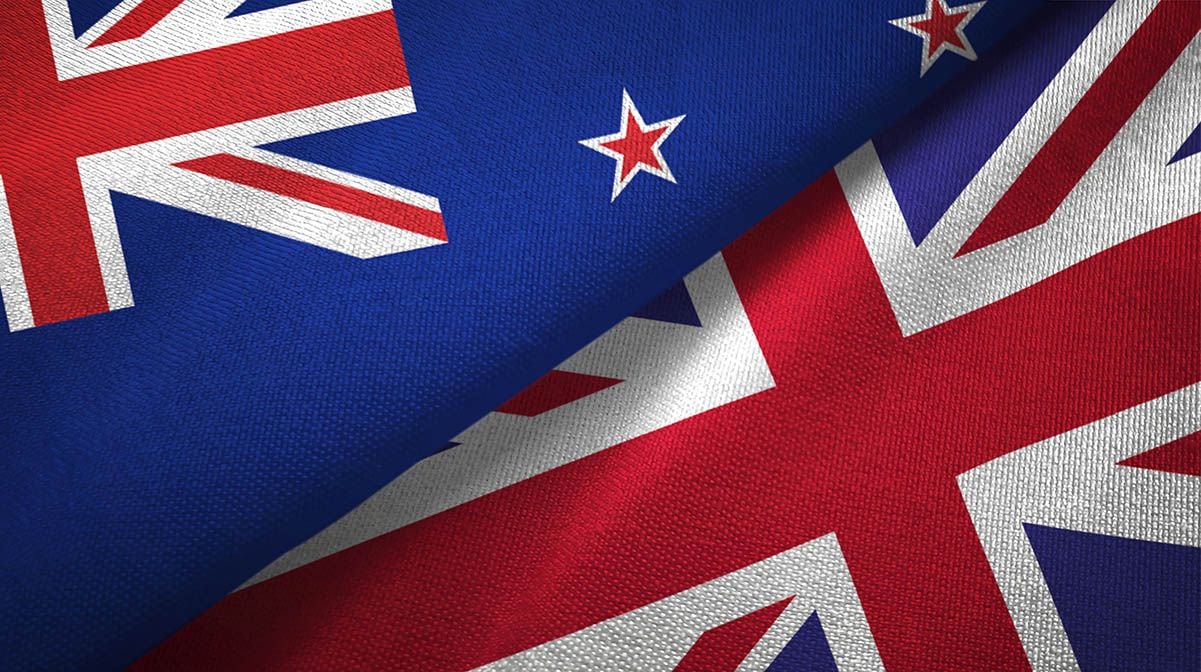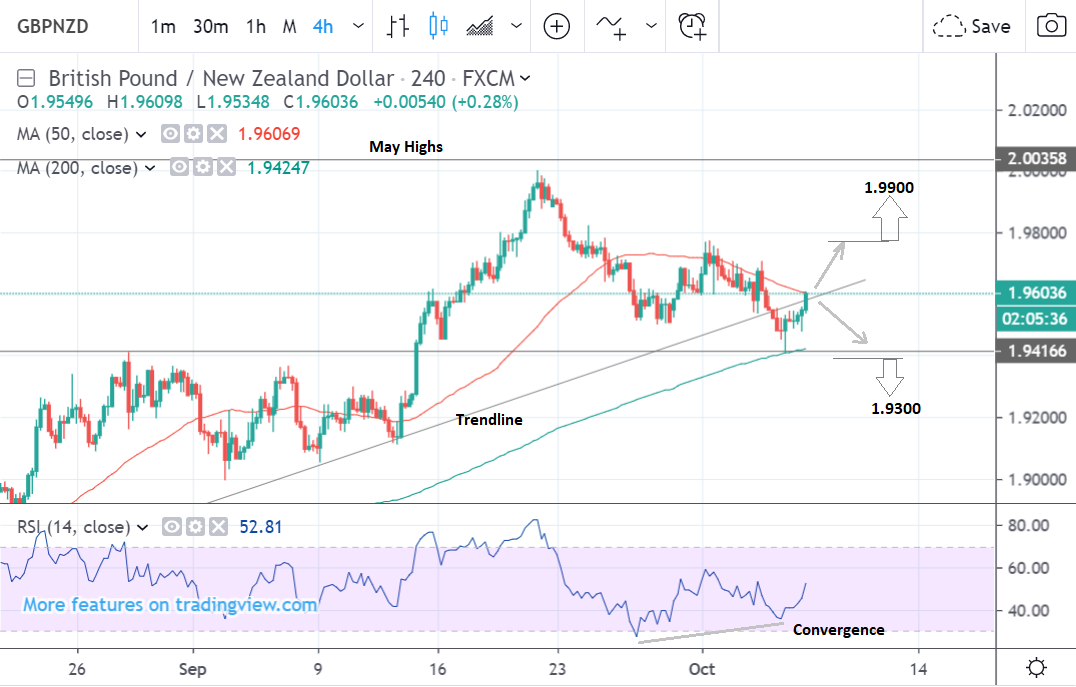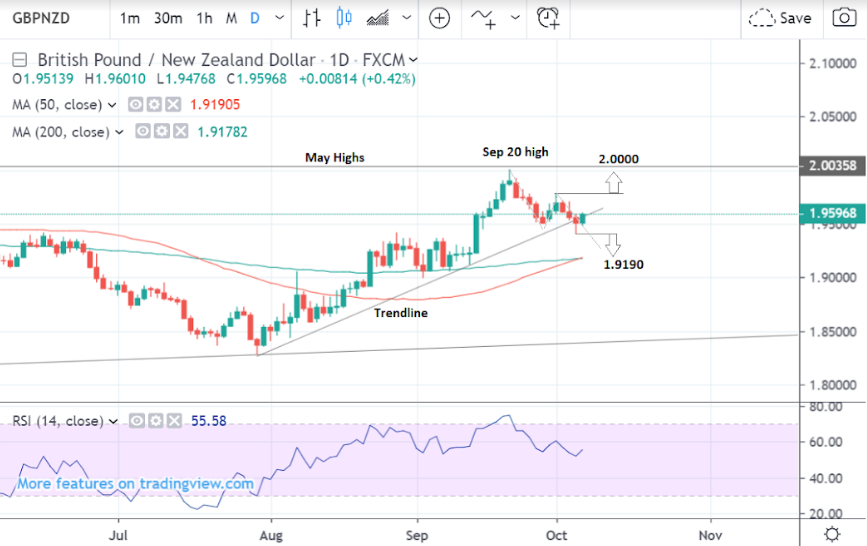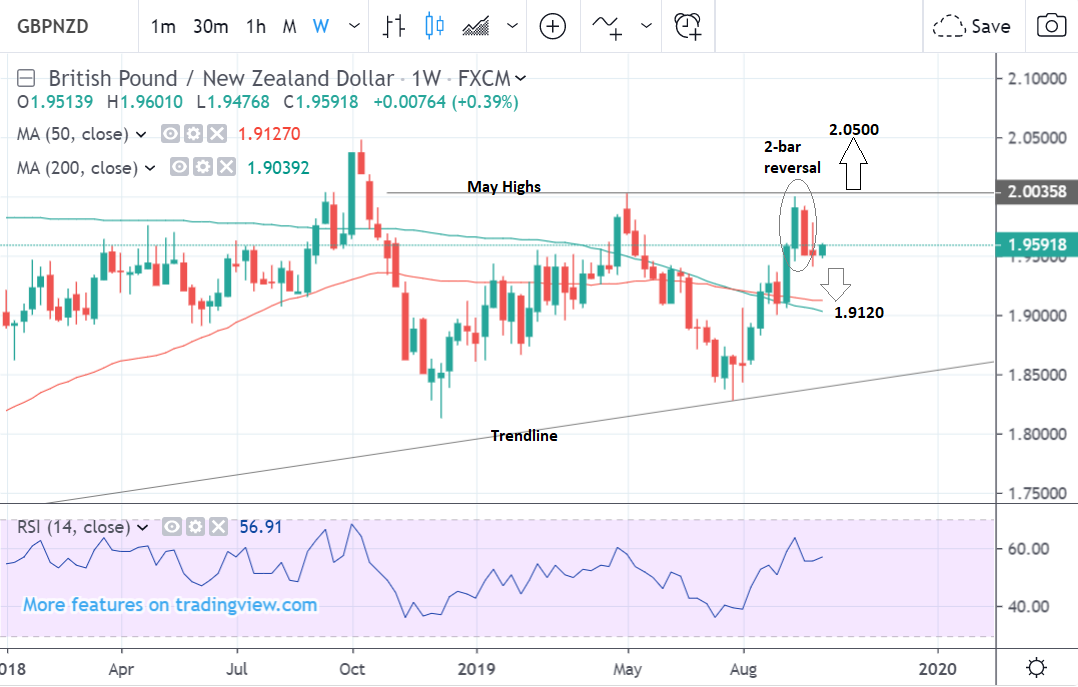Pound / New Zealand Dollar Rate on the Verge of Breakout

Image © Adobe Stock
- GBP/NZD rising after basing at support level on the charts.
- GBP at inflection point with possibility of break higher or lower.
- NZD to take cues from risk appetite as GBP eyes Brexit news.
The Pound-to-New Zealand Dollar exchange rate was trading around 1.9603 at the beginning of the new week, with studies of the charts suggesting balanced risks of either a break higher or lower over the coming five days.
The 4 hour chart - used to determine the short-term outlook, which includes the coming week - shows how the pair has been declining since retouching the May highs at the end of September.
It broke temporarily below a trendline which is a bearish sign but has since broken back above. From here the pair could go in either direction - it could rally higher to around 1.9800 or down to about 1.9400.

Above: GBP/NZD rate shown at 4-hour intervals.
A break above the 1.9775 highs would provide confirmation of a continuation higher to a target at 1.9900, whilst a break below the October 4 lows at 1.9400 would probably green-light a move down to 1.9300 initially.
The converging RSI indicator in the bottom panel adds a slightly bullish tilt to the chart but not enough to change our overall neutral stance.
The daily chart shows the full extent of the uptrend from the late July lows and how the pair touched resistance at the September 20 highs before pulling back down to the trendline.
There is a possibility the pull-back is merely a correction of the uptrend from late July which is about to resume and go higher. In such a scenario a break above 1.9775 would confirm a continuation up to a target at 2.0000.
Alternatively, the down-move may not be finished and could simply continue lower to a target at 1.9190 and the level of the 50 and 200-day MAs, which are likely to present a tough support floor. Such a move would be dependent on a break below 1.9400.
The daily chart provides a view of the medium-term outlook which includes the next week to month.

Above: GBP/NZD rate shown at daily intervals.
The weekly chart shows a slightly more bearish picture. At the last touch of the May highs the pair formed a 2-bar reversal pattern (circled) and subsequently fell lower. Although the downtrend has stalled the original 2-bar pattern is quite a strong bearish indicator and more downside is quite possible to support at 1.9120.
A break back above the 2.0000 highs, however, would reinvigorate the uptrend and probably open up a move up to a target at 2.0500. The weekly chart is used to give us an idea of the longer-term outlook, which includes the next few months.

Above: GBP/NZD rate at weekly intervals.
AA
The New Zealand Dollar: What to Watch
Global investor risk appetite is likely to be the biggest driver of the New Zealand Dollar (Kiwi) in the week ahead. Domestic data may also impact if it comes out radically different from expectations.
U.S - China trade talks taking place on Thursday could move the Kiwi. Early optimism, however, has given way to growing pessimism after the Chinese narrowed the agenda to only include certain elements of trade.
The Chinese do not wish to discuss intellectual property theft, state subsidies, and technology transfer even though these are areas the U.S. would want to cover as part of a comprehensive trade deal.
Given Trump has said he is not interested in anything less than a complete deal the chances of a breakthrough remain low. This comes despite incentives for both sides to do a deal, such as Presidential elections in the U.S. and Chinese growth slowing in China.
“What we’re doing is we’re negotiating a very tough deal. If the deal is not going to be 100% for us, then we’re not going to make it,” said Trump last Friday.
This is likely to weigh on the Kiwi which is sensitive to Chinese growth prospects.
The main data releases for the Kiwi are business NZ PMI which came out at 48.4 in August and electronic card sales, which rose 1.1%. These are scheduled for release on Thursday at 22.30 and 22.45 respectively.
If they come out substantially lower-than-expected they could impact on interest rate expectations and the Kiwi. Worse data tends to lead to lower interest rates and a weaker currency.
This is especially the case at the current time when investors see the possibility of the Reserve Bank of New Zealand (RBNZ) ‘easing policy’ by cutting interest rates in order to stimulate growth.
Recent “awful NZ business confidence and activity readings,” are “fresh in the minds of traders and investors,” says Jason Wong, an analyst at BNZ bank, and are “conspiring to add weight to the view that the RBNZ had a lot more easing to do.”
If he is right the Kiwi could see more weakness on the horizon.
The Pound: What to Watch
Brexit news will continue to dominate the Pound in the week ahead, whilst on the hard data front industrial and manufacturing production are the main releases along with the second estimate of Q2 GDP.
From a Brexit standpoint, the main focus will be on whether the UK and EU can strike a deal or at least a semblance of a deal - if they can the Pound could rise strongly. Dominic Cummings, a leading force behind the UK's Brexit strategy, has reportedly told aides that if the EU do not strike a compromise and agree to a new plan this week then the UK will be leaving without a deal.
The stakes are certainly high, particularly as there is very little insight into how Prime Minister Boris Johnson intends to exit the EU without a deal on October 31.
According to government papers submitted to a Scottish court on Friday, Johnson will send a letter to the European Union asking for a Brexit delay if no divorce deal has been agreed by October 19. This means the Government intends to abide by the Benn Act which forces the Prime Minister to seek a Brexit extension if a deal has not been passed by parliament on October 19.
However, the British Pound actually went lower on the day as Government sources maintained that while they intend to follow the law, they will still not seek a delay. Steve Baker, the Conservative MP who heads up the party's Eurosceptic European Research Group responded to the government's court papers saying: "a source confirms all this means is that Government will obey the law. It does not mean we will extend. It does not mean we will stay in the EU beyond Oct 31. We will leave."
The UK recently submitted an alternative proposal to solve the problem of the Irish 'backstop' but the initial reaction of leading EU Brexit negotiators and stakeholders was not very positive and suggests the two sides were a long way from meeting in the middle.
Leo Varadkar, the prime minister of Ireland, said the UK’s present proposals “do not form the basis for deeper negotiations.”
The EU's chief Brexit negotiator Michel Barnier said, “there’s improvement...we are not there yet,” but privately was concerned about the proposal’s custom’s checks on the island of Ireland, a red-line for the EU.
Guy Verhofstadt, who heads up the EU Parliament's Brexit oversight committee commented that the proposals were “not positive in that we don’t think really there are the safeguards that Ireland needs.”
The proposal was however well-received by the government’s own party, however, including leading Brexiteers on the one hand and rebel Tory independents on the other. We noted that there is a decent chance the Government could win a majority were they to present a deal based on their latest plans, and this is an all-out positive development for Sterling.
A deal still looks to be some way off however as the further the government moves to meet the demands of the EU, who basically want a customs union in Ireland, the more it will alienate the ERG and DUP, without whose support it has no chance of getting the deal approved by Parliament.
This may overall lead to further pressure on the Pound in the week ahead.
Turning to the economic data, investors will be closely watching industrial and manufacturing data, which are both expected to show a -0.1% result in August from 0.1% and 0.3% respectively in July, when released on Thursday and 9.30 BST.
A combination of Brexit uncertainty and the global manufacturing slowdown have started to show up in British economic data and the recent Services PMI report said there was a heightened chance of a technical recession happening in the UK.
If the results show a deeper-than-expected contraction in the data the Pound will probably weaken.
Q2 GDP is expected to remain unrevised for its second estimate, with the quarterly reading to continue to show 0.0% growth, yearly 1.3% and monthly 0.3%.
If results are revised down the Pound will follow suit.
Time to move your money? Get 3-5% more currency than your bank would offer by using the services of foreign exchange specialists at RationalFX. A specialist broker can deliver you an exchange rate closer to the real market rate, thereby saving you substantial quantities of currency. Find out more here.
* Advertisement





